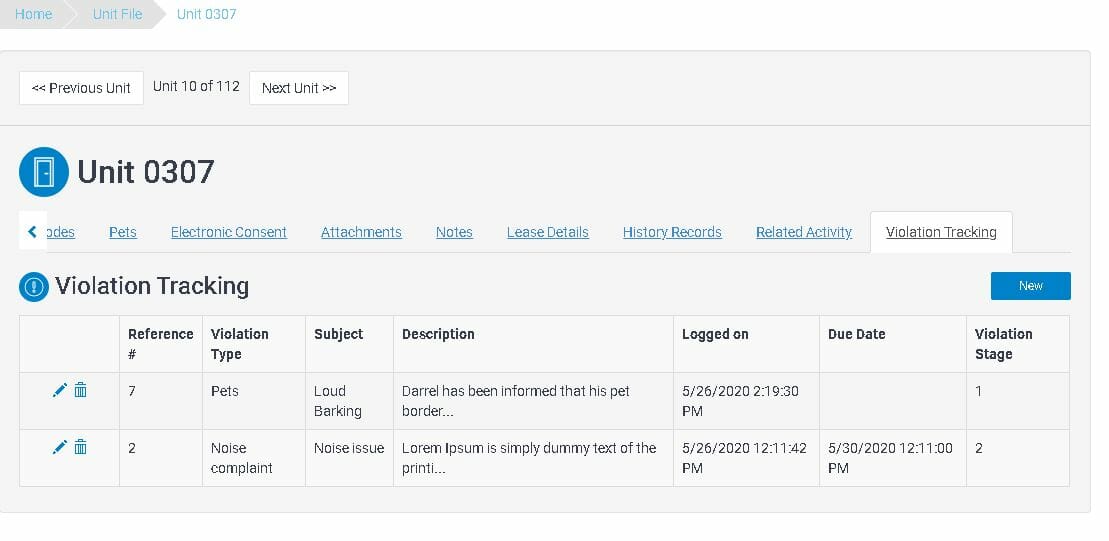Violation tracking can be a lot of work, especially if you are logging and updating violations manually. It’s one of the more tedious duties of a board member or manager, however, it is also a necessary task.
There’s no singular way to track and manage the violations that occur within your community, but some systems are more effective than others.
Below is a collection of valuable tips to help you simplify and improve your violation tracking process.
Table of contents
- Familiarize yourself with the rules
- Have a formal system in place
- Use technology to track and manage violations
- How to reduce violations
Familiarize yourself with the rules
You can’t expect your residents to know the bylaws and rules if you aren’t sure of what they are. Take time to read over your HOA’s governing documents on a regular, perhaps quarterly basis. While no one expects you to memorize every rule, you should be familiar with them so that you know where to look when you need guidance on how to handle a specific issue.
Have a formal system in place
Issuing violations as they happen can be draining and inefficient if your HOA doesn’t have a formal system in place. Violation notices need to be consistent and predictable. An owner should know that if they don’t pick up after their pet, they will receive a notice and pay a predetermined fine.
It would be completely unfair if some owners were charged different amounts for breaking the same rule. Similarly, it would be unfair if an owner who forgot to mow their lawn was fined the same amount as an owner who caused significant damage to the development. Be sure that you’re consistent in both assessing and enforcing fines.
There should also be a formal method for issuing violations. That includes the method of distribution, and timing. Recipients must be given a reasonable amount of time to correct the issue before it is escalated.
Depending on where your HOA is located, there can be differences in how homeowners must be notified of violations.
Some states do have laws that govern how and when notices must be given, what details they must contain, and how they must be delivered or served. In other states and provinces that have less formal requirements, the governing documents should determine how notices must be given.
Think of it this way, regardless of who is issuing the violation, the information in the notice, the fine (if applicable) and the method of distribution should not change. A formal violation system ensures consistency, and that’s a good thing.
Use technology to track and manage violations
Once your board has established a system for issuing and resolving violations, the next step is to create a system for tracking and managing the violations. Online software can help automate this tedious process and reduce the time you spend logging details by hand.
Condo Control’s Violation Tracking feature allows board members, management, and even concierge or security to log, track, and manage violations online. The software streamlines and simplifies the entire violation process.

Setting up violations
Administrators have the control to set up customized violation categories, or types. You can log violations based on noise, parking, landscaping, pets, and more. These categories can be edited or deleted instantaneously.
The resolution system you created for each violation can easily be transferred online. Set actions can be assigned to specific violations, meaning different processes will be carried out depending on the type of violation that was committed.
Send notices automatically, address issues faster
Not only does online software give you the control to program violation processes and procedures, you can also send a personalized notice directly to the offending homeowner. Provided that your association allows you to send violation notices electronically, you can easily deliver a warning letter or notice to a designated unit or individual. There is no need to print or mail paper copies.
The resident has the opportunity to respond to the notice or ask any questions they may have. All transactions are securely saved on Condo Control’s cloud platform so that if you ever need to review a previous conversation with a resident, you can easily find it.
Residents can even pay fines through the Violation Tracking feature. By giving them the ability to pay online, you don’t have to spend extra time chasing homeowners for cheques. With this online tool, violations can be resolved in a day.
Status updates
As the status of a violation progresses, you can update the issue with a couple of clicks. Set each violation to open, pending, or closed. You may request to be notified every time a new violation is created or updated by another administrator so that you are always aware of when new issues arise, and when outstanding violations are resolved.
You can view all registered violations from one comprehensive list, and monitor which issues have not been taken care of. Due dates let you know how much time a resident has to remedy an issue.
The bigger picture
Condo Control’s Violation Tracking feature can help you stay on top of day-to-day tasks, but it can also provide you with insightful information that will assist you with long-term planning. The system automatically tracks how many times a type of violation has been documented for each unit or house so you can easily see if a resident is having difficulty abiding by a certain rule.
You can also run a report to see which violations occur most frequently, or when they are most likely to be committed. Using that data, you can make decisions about how to reduce the number of violations that occur in your community.
How to reduce violations
Having a comprehensive violation tracking system in place will make violation management much easier, however, the absolute best way to simplify the violation tracking process is to prevent violations from occurring in the first place. If your residents comply with the HOA rules, you won’t have to spend so much time enforcing them.
Good communication
We can’t stress this enough. Good communication is crucial when it comes to rule compliance (and every other HOA issue for that matter). Everybody in the community is bound by the rules, even if they’ve never taken a good look at them. But, if they’ve never had an opportunity to read and process HOA rules, then how can homeowners know what is expected of them? If the association’s CC&Rs, bylaws, and rules and regulations are not easily accessible, it’s time to change that.
You can print out and distribute copies of these documents for each homeowner, but that can be costly, and it isn’t very eco-friendly. A better alternative is to post the documents online. Ideally, these documents will be stored in a file library or on the association’s website. You could also email your homeowners digital copies of the documents so that they always have a copy on hand.
If possible, send owners a notice of any rules that are coming into effect, rules that have been amended, or rules that will become important, once every three months. For example, send out a notice in early spring to remind homeowners about landscaping rules.
Be flexible, be reasonable
Different communities will have different processes, but issuing a warning letter before an official notice is served can be quite effective.
When written well, a warning letter can act as a gentle reminder to the homeowner. They may not have been aware that the rule they broke existed, or they may have forgotten about the rule. Either way, sending a letter before issuing a violation shows the homeowner that the HOA can be compassionate and reasonable. Furthermore, the homeowner is more likely to comply with the rule if they’ve received a friendly warning first (a violation notice never sits well with anyone, even if they have committed the offence).
Depending on your comfort level, you could also have a conversation with the homeowner. Talk to them and allow them to ask questions. When you do that, you can try to mitigate the problem right there and then.
If the offence is serious, then a warning letter is probably not appropriate, but many small violations can be addressed this way.
Think beyond fines
If someone is purposefully breaking the rules and is ignoring the violation notices and fines you’ve sent, then the board may have to take legal action to address the problem. It’s not something any board wants to do, but you can’t allow a homeowner to brush the rules aside. Check your governing documents to see if the association can recover costs if it must go to court and it successfully argues its case.
If a homeowner knows they may be on the hook for the association’s legal fees as well as any fees that a judge orders them to pay, this could be enough to persuade them to pay the outstanding fines instead. You may also be able to suspend an owner’s right to vote, or use share facilities.
Conclusion
There’s no big secret when it comes to effective violation management. Planning, proper organization and good communication are key to simplifying the process.
Violation Tracking
Learn more about our violation tracking & management feature


